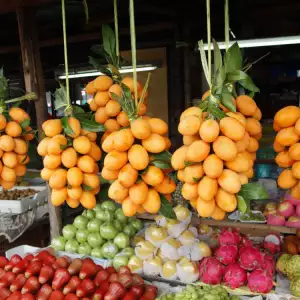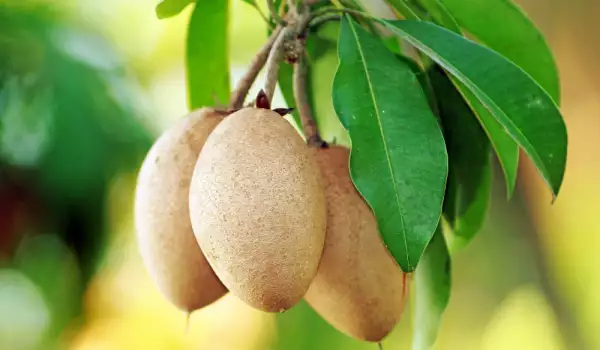Sapodilla, Manilkara Sapota, also known as tree potato is a beautiful evergreen tree that has smooth straight trunk and thick bark. Sapodilla belongs to the Sapota family. This is a very slow-growing plant that in open spaces reaches a height of about 54 ft (18 meters) and in the forest reaches an impressive 90 ft (30 meters).
Sapodilla originated from southern Mexico, the Yucatan Peninsula and north-eastern Guatemala. Grown throughout Central America, Florida, India, Sri Lanka. One of the main reasons for the wide spread of sapodilla is resistance. Withstands frosts and droughts.
Fruits of the sapodilla plums are fleshy and reddish-brown in color. Reach sizes of 1.5 - 3" (3 to 8 cm), inside the fruits are 8 seeds, which are black in color. The weight of each fruit is about 5.3 oz (150 g).
Composition of sapodilla plums

Sapodilla plums are rich in polyphenolic compounds, tannins, fibre large amounts of antioxidants - vitamin C and vitamin A. 3.5 oz (100 g) sapodilla plums contain 25% of the recommended intake of vitamin C.
Sapodilla is rich in copper, potassium, iron, niacin, pantothenic acid and folic acid. The fruits are composed of easily digestible fibre and simple sugars, such as fructose and sucrose.
Selecting and storing sapodilla plums
Sapodilla is a popular fruit. Some specialized shops offer seeds of the fruit. Order it in advance, and delivery takes place within up to a few months.
Use of sapodilla plums
This tree is mainly used for the production of chewing gum, which is produced from the resin of the tree, known as chicle.
Back in 1871, in South and Central America, gum was patented, as a resin obtained from the tree was mixed with sugar and various spices to improve the taste.
Chicle is a natural rubber, which is collected from the tree. There is evidence of its use by the Mayans. Collected from July to February, during the rainy season. The bark of sapodilla splits and it releases juice.
This is carefully collected, filtered and heated. The liquid is converted to resin which is suitable for forming the gum cube. Sapodilla plums from a tree annually amount to 6.6 - 8.8 lb (3-4 kg) of product.
It is interesting that such a process does not harm the plant, but the next collection of resin can be done only after 3 years.

Chief producer of chicle is Mexico, which exports more than 2, 000 tons per year to world markets and the United States. Due to the depletion of chicle as a raw material, gum today is mostly made of rubber mixing, oil and other types of resins.
Furthermore to chicle, the tree bears and delicious fruits. They have a transparent gelatinous flesh but green fruits are preferable because they contain gum and stick to your gums.
However, the ripe fruits are very sweet and delicious, but contain no rubber. In appearance, it is similar to an apple.
The fruits are eaten fresh, but before consumption, the seeds must be removed because they contain hydrocyanic acid.
Benefits of sapodilla plums
The rich fibre content in sapodilla plums makes a good laxative. Fibbers help to alleviate constipation and protect the lining of the colon of serious diseases, such as cancer.
The large amount of antioxidant vitamins in sapodillas make it a valuable health fruit. The vitamin A in the fruit is essential for vision.
Minerals and vitamins in sapodillas are essential for optimum health, because they are included in various metabolic processes.
Besides the edible fruit of the tree, the bark and seeds are used too. Juice extracted from the bark is used in fever and diarrhea, and from the interior of the seed oil is extracted, which helps in hair loss and skin irritation.







